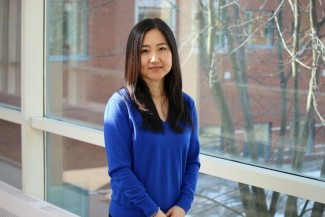Cord Blood Awareness Month: Q&A with researcher Jennie Haw

Dr. Jennie Haw is a scientist at Canadian Blood Services’ Centre for Innovation. She was a Canadian Institutes of Health Research (CIHR) Health System Impact postdoctoral fellow from 2017—2019. Her research project during this fellowship focused on optimizing cord blood donor recruitment for the national public cord blood bank. As a sociologist, she’s interested in understanding how health and health systems relate to the individual and society.
As we celebrate Cord Blood Awareness Month this July, we sat down with Dr. Haw to talk about her research and its impact on cord blood banking.
What’s your focus of research in health systems and individuals and society?
As a health sociologist, I’m interested in understanding the intersection of health, people and society. That’s a broad area that includes studying topics such as how people engage with and access health services, people’s understanding and experiences of health, and how broader social and political context influences health systems. As a sociologist, I always think about the individual person (micro-level) in relation to organizations (meso-level) and society (macro-level) and how these various levels influence each other. Since 2017, when I began working with Canadian Blood Services as a postdoctoral fellow, my research has focused on donors and donation. My postdoctoral research project examined donor recruitment and cord blood collection to optimize these processes. For this project I interviewed cord blood collection staff and mothers who had donated or wanted to donate their babies’ cord blood to examine the donation process from their perspectives.
From a sociologist’s perspective, what are your thoughts on cord blood and what kind of impact do you expect to see this precious resource have on health systems in Canada and globally?
I think cord blood donation and the national public cord blood bank are highly valuable from the perspective of mothers who donate and from the perspective of the Canadian health system. It’s clear that mothers who are able to donate view cord blood donation as a socially meaningful act that they share with their newborn. From the perspective of the Canadian health system, a robust national public cord blood bank increases the likelihood that a patient who needs a stem cell transplant from an unrelated donor will find a match. We know that people are more likely to find a match from someone who shares similar ethnic ancestry, so having a cord blood bank inventory that reflects the ethnic diversity of the Canadian population is valuable. If we apply a health equity lens, having a bank with cord blood units from ethnically diverse donors is consistent with efforts to ensure equitable access to finding a stem cell match for everyone in Canada. Since the cord blood bank lists their units on an international registry, a strong inventory also improves access to and likelihood of finding a match for patients around the world.
Interestingly, with global travel restrictions enforced to contain the spread of COVID-19, cord blood as a source of blood stem cells seems to be increasingly important. I think it’ll be very interesting to see what happens to cord blood use as the pandemic evolves around the world.
You have spoken with donors and potential donors to Canadian Blood Services’ Cord Blood Bank to understand cord blood recruitment and donation from their perspective. What did you hear from these moms?
I learned a lot from mothers who donated or wanted to donate to the cord blood bank. As I mentioned earlier, most women spoke about donating cord blood as a meaningful act and of the value they placed on being able to help other children and people who need a stem cell transplant. They understood that it was very unlikely that their own child would need cord blood in the future, so they wanted to put the cord blood to use in some other way — whether it was to help someone else or used in research. Most mothers also viewed their donation as contributing to a public health resource that their child or someone else in their family might benefit from in the future. In other words, mothers donated cord blood to help others in the shorter-term and to support a public resource that their child might need to draw upon in the longer-term. Many mothers also spoke about donating cord blood as an act that builds community, and for some this was particularly significant because they felt they were building the type of community, one in which people help each other, that they wanted for their child.
Could your research impact on patient outcomes?
Yes, I think my research could potentially impact patient outcomes. The aim of the project was to optimize donor recruitment and cord blood collection, so one important area that I wanted to understand was what worked (i.e., facilitators) and didn’t work (i.e., challenges) for mothers who donated their babies’ cord blood. The more the cord blood bank knows about facilitators of and challenges to recruitment and donation from the donor’s perspective, the better they’ll be able to ensure a good experience for donors. If we can improve donor recruitment and cord blood collection and build a robust, ethnically-diverse inventory of cord blood units, this increases the likelihood that a patient who needs a stem cell transplant will find a match. For example, while many mothers said they found the registration process very easy and seamless, some spoke about wanting to know more about the process of donation. The cord blood bank recognizes this challenge and is already exploring additional ways to inform women of the donation process and to provide follow-up regarding their donation.
Many mothers also spoke about donating cord blood as an act that builds community, and for some this was particularly significant because they felt they were building the type of community, one in which people help each other, that they wanted for their child.
Do you recall an interesting experience you had while conducting fieldwork? Perhaps you could tell us about any findings related to social and cultural diversity.
I found that conducting interviews with some cord blood donors was a “family affair.” What I mean by that is that many of the mothers who participated were also caring for their baby while doing the interview. I really appreciated their interest in participating in the study despite everything else they were doing. For some mothers, the best time to talk was when they were on a walk with their baby since this was when their child was most quiet and calm. It was clear they were busy and juggling many responsibilities, not the least of which was caring for a baby, but they made time to participate in the research study.
In terms of social and cultural diversity, I found that moms who identified as being from diverse ethnic ancestry, were highly motivated to donate their babies’ cord blood when they learned of the need for cord blood from underrepresented ethnic ancestries. They felt it was very important to contribute to their community.
Did you encounter any unexpected findings and how did this impact your research?
An unexpected finding emerged in the interviews I conducted with cord blood collection staff for this project. There has been very little research done on their perspectives, and I was unaware of the extent of the complexities and challenges of in-hospital recruitment and cord blood collection. Since these processes are done in the context of a busy labour and delivery unit in a hospital and during a very significant time for mothers and their partners, collection staff must navigate a clinical hospital environment and meet the physical and emotional needs of donors, all while maintaining collection and manufacturing standards. Interview data from cord blood staff demonstrated the technical skills and emotional labour required by staff to be able to do their work well and effectively. These findings were supported by my interviews with donors who also spoke very positively about their interactions with cord blood staff. One donor said that she thought cord blood staff were “game changers” and highly instrumental in ensuring a successful donation process. I think this speaks to the importance of the relationship between donors and collections staff and the skills necessary to provide effective donor care.
Anything you want to add?
Conducting this research gave me a deeper appreciation for cord blood donors and their commitment to donate. For most women, pregnancy is a very busy time and giving birth is a highly significant life event, and I was encouraged by their desire and efforts to donate.
Canadian Blood Services – Driving world-class innovation
Through discovery, development and applied research, Canadian Blood Services drives world-class innovation in blood transfusion, cellular therapy and transplantation—bringing clarity and insight to an increasingly complex healthcare future. Our dedicated research team and extended network of partners engage in exploratory and applied research to create new knowledge, inform and enhance best practices, contribute to the development of new services and technologies, and build capacity through training and collaboration. Find out more about our research impact.
The opinions reflected in this post are those of the author and do not necessarily reflect the opinions of Canadian Blood Services nor do they reflect the views of Health Canada or any other funding agency.
